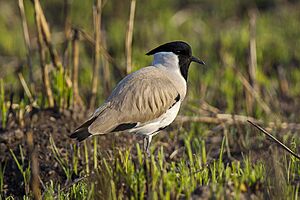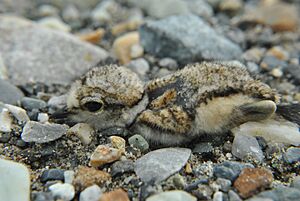River lapwing facts for kids
Quick facts for kids River lapwing |
|
|---|---|
 |
|
| Conservation status | |
| Scientific classification | |
| Genus: |
Vanellus
|
| Species: |
duvaucelii
|
| Synonyms | |
|
Charadrius duvaucelii Lesson, 1826 |
|
The River Lapwing (Vanellus duvaucelii) is a cool bird found in parts of Asia. It's a type of lapwing, which are birds known for their loud calls and unique looks. You can find them in places like India, Vietnam, and other countries in Southeast Asia. These birds usually stay in one place and don't fly far away for winter.
Sometimes, people used to call them 'spur-winged lapwings.' But that name is now mostly used for a different bird in Africa. The River Lapwing's scientific name, duvaucelii, honors a person named Alfred Duvaucel.
Contents
What Does a River Lapwing Look Like?
River Lapwings are medium-sized birds, about 29 to 32 centimeters long. That's roughly the length of a school ruler! They have a striking look with a black crest on their head. Their face, the top of their head, and the middle of their throat are also black.
Their neck sides and the back of their neck are a grey-white color. They have a grey-brown band across their chest. Their belly is white, but it has a black patch. The back of the bird is brown, while its rump (the area just above the tail) is white. Their tail is black.
Flying High
When a River Lapwing flies, it looks amazing! You can see its black primary feathers (the long feathers at the wingtips). The feathers under its wings and the secondary feathers on the top of its wings are white. The upper part of its wings, near the body, is brown.
Both male and female River Lapwings look very similar. However, males are usually a little bit bigger than females. Young birds have brown tips on their black head feathers. Their backs are a sandier brown, and their upper body and wing feathers have pale edges.
What Do They Sound Like?
The call of the River Lapwing is a sharp sound. It often sounds like "tip-tip" or "did-did-did."
How River Lapwings Behave
River Lapwings have interesting ways of showing off, especially when they are looking for a mate. They perform a special dance on the ground. This dance includes bending down, spinning around, stretching, and raising their crest.
Nesting and Eating
River Lapwings build their nests on banks made of small stones and sand. They do this between March and June. They lay two eggs right on the ground in a small hollow they scrape out.
These birds find their food in wet grasslands and farmlands nearby. They eat insects, worms, crustaceans (like crabs), and molluscs (like snails). River Lapwings usually like to be by themselves and don't often gather in large groups.




